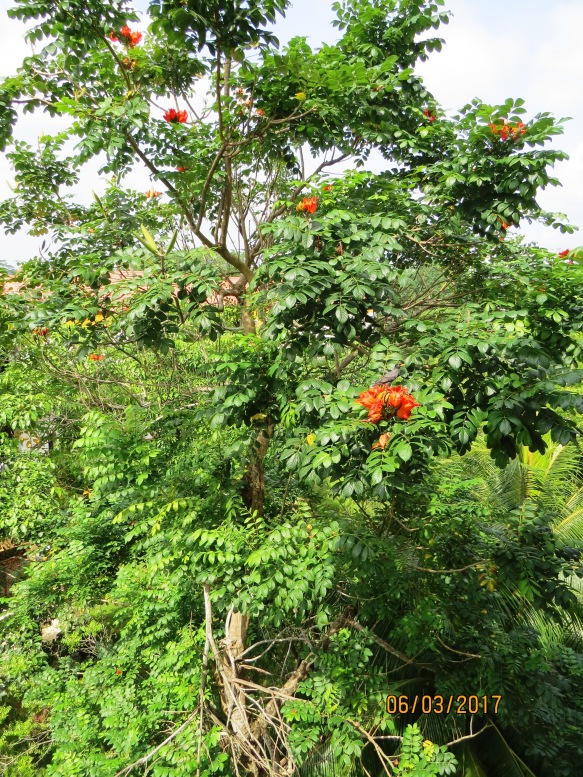Contributed by Morten Strange, retired photographer, author and publisher, now an independent financial analyst.
The African Tulip Tree Spathodea campanulata is widely used in Singapore as an introduced ornamental tree, locally known as Flame of the Forest. We have one of those right outside our apartment on the fourth floor off lower Sembawang Road. Over the years the tree has grown up, so it is now right outside our windows, ideal for armchair birding! You get stunning point-blank eye-level views of all the common stuff, and now and then a few more difficult-to-see-well species.

The whole African Tulip Tree seen tree from our window.
Every morning we wake up to the fluty whistle of the Black-naped Oriole, it seems to call all year. When I grew up in Europe I hardly ever saw an oriole, the European species O. oriolus is really hard to find in the north; here we are lucky to have the stunning O. chinensis so easy to see. The call from the Asian Koel appears to be more seasonal; how that exciting cry can be a bother to anyone is a puzzle to me! Occasionally we get the sweet song from the Oriental Magpie-Robin.

The hidden cry from the male Asian Koel.
When the tree is in flower, the nectar-feeders come swarming in and flutter in and out of the tree all day. We get the two common species of sunbirds as you can imagine, as well as Oriental White-eye, Yellow-vented Bulbul and of course the every-where present Javan Myna.

Our environmental refugee the Javan Myna is just so amazingly omnivorous, you cannot help but feeling some sympathy for this adaptable foreign worker.
We used to regard this species as a pest here, and it is one of only six bird species that you are allowed to kill according to Singapore legislation. But since it was uplisted to globally Vulnerable to extinction last year, we might have to view it in a slightly different light: As an environmental refugee from its native range in Java and Bali, where it is widely persecuted with capture and imprisonment (I mean caging …), a species worthy of our protection in exile!?

Flowering season – male Brown-throated Sunbird.
Scarlet-rumped Flowerpecker visits the tree but does not seem to use the flowers. However, many insects do, and they in turn attract the Blue-tailed Bee-eater which is also a prolific and attractive visitor during flowering.
When the flowers turn into fruits, the parrots arrive and chew on them to get to the seeds. Rose-ringed Parakeet is most regular, but we also get Red-breasted and Long-tailed and the occasional Tanimbar Corella. My favorite however, is the diminutive and acrobatic Blue-crowned Hanging Parrot, they come in late in the afternoon; you always know when they are there from their ringing whistle.

When the flowers turn into fruits, the parrots arrive, here the attractive and acrobatic Blue-crowned Hanging Parrot.
I have never seen a bird nest in the tree, although we have Pink-necked Green Pigeon nesting other places in the estate. We did have a nest of Plantain Squirrel right outside our window one year. The Philippine Glossy Starling collects nesting material from the tree, and couples use it as a spring-board when they fly into their nests under the roof of our building. In the migratory season Asian Brown Flycatcher and occasionally Oriental Honey-Buzzard perch for a while.

My son Mark took this great shot of a Common Flameback male one day. I didn’t even know it had white dots in the primaries!?
Although we are at least a kilometer from the nearest proper secondary forest, we get some forest edge species visiting such as Hill Myna, Banded Woodpecker and occasionally Oriental Pied Hornbill and Greater Racket-tailed Drongo. In total more than 30 species of birds use that tree.
I sold all my camera equipment many years ago. But now and then I pick up a compact camera belonging to my son or wife and snap a few pictures of the birds in the tree for fun. Not because I think we need any more images like these, but to send the message out that you don’t have to travel to remote and exotic places to study and enjoy nature.

The ubiquitous Yellow-vented Bulbul very at home at every “local patch”
It was the British comedian and birder Bill Oddie who popularized the concept of the ‘local patch’. Our local patch is Springleaf Nature Park near our place; but in fact we don’t really even have to go anywhere to watch birds these days, they are right outside our window. We have already lost a few large branches in the tree, and one day I expect that a storm will snap off the crown completely. But until then we will enjoy it every day.
Morten Strange
http://en.wikipedia.org/wiki/Morten_Strange

Lovely write up about the fact that sometimes our doorstep offers the best birding possibilities!!thanks
LikeLike
Really interesting article, thanks!
LikeLike
Thanks Reuben Morten was a pioneer in bird photography back in the 80s. He also authored many bird guides and books of SEA birds before retiring.
LikeLike
Well written article and good record of birds that use the African Tulip tree.
LikeLike
That’s a weluotholght–ut answer to a challenging question
LikeLike
Hi. May I ask where exactly this tree is? I am going a tree hunt for various tree species in Singapore and this is on my list!
LikeLike